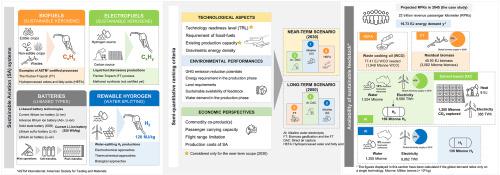Progress in Energy and Combustion Science ( IF 29.5 ) Pub Date : 2023-02-11 , DOI: 10.1016/j.pecs.2023.101073 Pimchanok Su-ungkavatin , Ligia Tiruta-Barna , Lorie Hamelin

|
Climate neutrality is becoming a core long-term competitiveness asset within the aviation industry, as demonstrated by the several innovations and targets set within that sector, prior to and especially after the COVID-19 crisis. Ambitious timelines are set, involving important investment decisions to be taken in a 5-years horizon time. Here, we provide an in-depth review of alternative technologies for sustainable aviation revealed to date, which we classified into four main categories, namely i) biofuels, ii) electrofuels, iii) electric (battery-based), and iv) hydrogen aviation. Nine biofuel and nine electrofuel pathways were reviewed, for which we supply the detailed process flow picturing all input, output, and co-products generated. The market uptake and use of these co-products was also investigated, along with the overall international regulations and targets for future aviation. As most of the inventoried pathways require hydrogen, we further reviewed six existing and emerging carbon-free hydrogen production technologies. Our review also details the five key battery technologies available (lithium-ion, advanced lithium-ion, solid-state battery, lithium-sulfur, lithium-air) for aviation. A semi-quantitative ranking covering environmental-, economic-, and technological performance indicators has been established to guide the selection of promising routes. The possible configuration schemes for electric propulsion systems are documented and classified as: i) battery-based, ii) fuel cell-based and iii) turboelectric configurations. Our review studied these four categories of sustainable aviation systems as modular technologies, yet these still have to be used in a hybridized fashion with conventional fossil-based kerosene. This is among others due to an aromatics content below the standardized requirements for biofuels and electrofuels, to a too low energy storage capacity in the case of batteries, or a sub-optimal gas turbine engine in the case of cryogenic hydrogen. Yet, we found that the latter was the only available option, based on the current and emerging technologies reviewed, for long-range aviation completely decoupled of fossil-based hydrocarbon fuels. The various challenges and opportunities associated with all these technologies are summarized in this study.
中文翻译:

生物燃料、电燃料、电力还是氢?:对当前和新兴可持续航空系统的回顾
在 COVID-19 危机之前,尤其是之后,气候中和正在成为航空业的一项核心长期竞争力资产,该行业内设定的多项创新和目标证明了这一点。设定了雄心勃勃的时间表,涉及将在 5 年时间范围内做出的重要投资决策。在这里,我们对迄今为止揭示的可持续航空替代技术进行了深入审查,我们将其分为四大类,即 i) 生物燃料,ii) 电燃料,iii) 电动(基于电池)和 iv) 氢航空. 审查了九种生物燃料和九种电燃料途径,我们为此提供了详细的工艺流程,描绘了所有输入、输出和产生的副产品。还调查了这些副产品的市场吸收和使用情况,以及未来航空的总体国际法规和目标。由于大多数库存途径都需要氢气,我们进一步审查了六种现有和新兴的无碳制氢技术。我们的评论还详细介绍了航空可用的五种关键电池技术(锂离子电池、高级锂离子电池、固态电池、锂硫电池、锂空气电池)。已经建立了一个涵盖环境、经济和技术绩效指标的半定量排名,以指导选择有前途的路线。电力推进系统的可能配置方案已记录并分类为:i)基于电池,ii)基于燃料电池和 iii)涡轮电动配置。我们的审查将这四类可持续航空系统作为模块化技术进行了研究,然而,这些仍然必须与传统的化石基煤油混合使用。这是由于芳烃含量低于生物燃料和电燃料的标准要求,电池的储能能力太低,或者低温氢的次优燃气涡轮发动机。然而,我们发现,根据审查的当前和新兴技术,对于完全脱离化石碳氢燃料的远程航空,后者是唯一可用的选择。本研究总结了与所有这些技术相关的各种挑战和机遇。在电池的情况下,能量存储容量太低,或者在低温氢的情况下,燃气涡轮发动机不够理想。然而,我们发现,根据审查的当前和新兴技术,对于完全脱离化石碳氢燃料的远程航空,后者是唯一可用的选择。本研究总结了与所有这些技术相关的各种挑战和机遇。在电池的情况下,能量存储容量太低,或者在低温氢的情况下,燃气涡轮发动机不够理想。然而,我们发现,根据审查的当前和新兴技术,对于完全脱离化石碳氢燃料的远程航空,后者是唯一可用的选择。本研究总结了与所有这些技术相关的各种挑战和机遇。



























 京公网安备 11010802027423号
京公网安备 11010802027423号